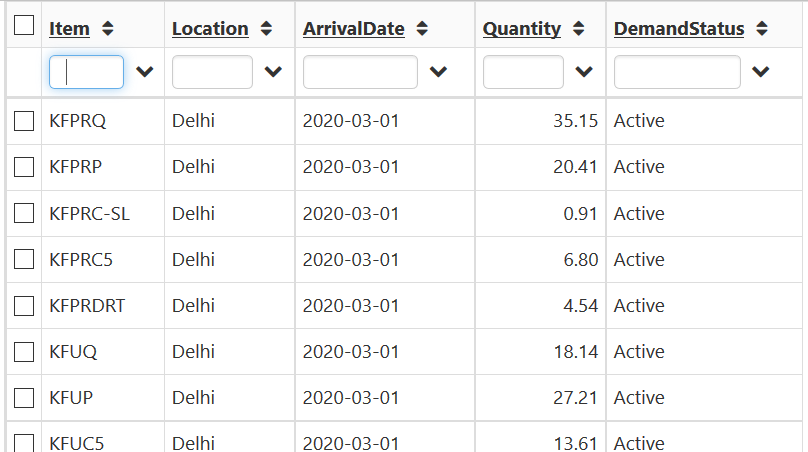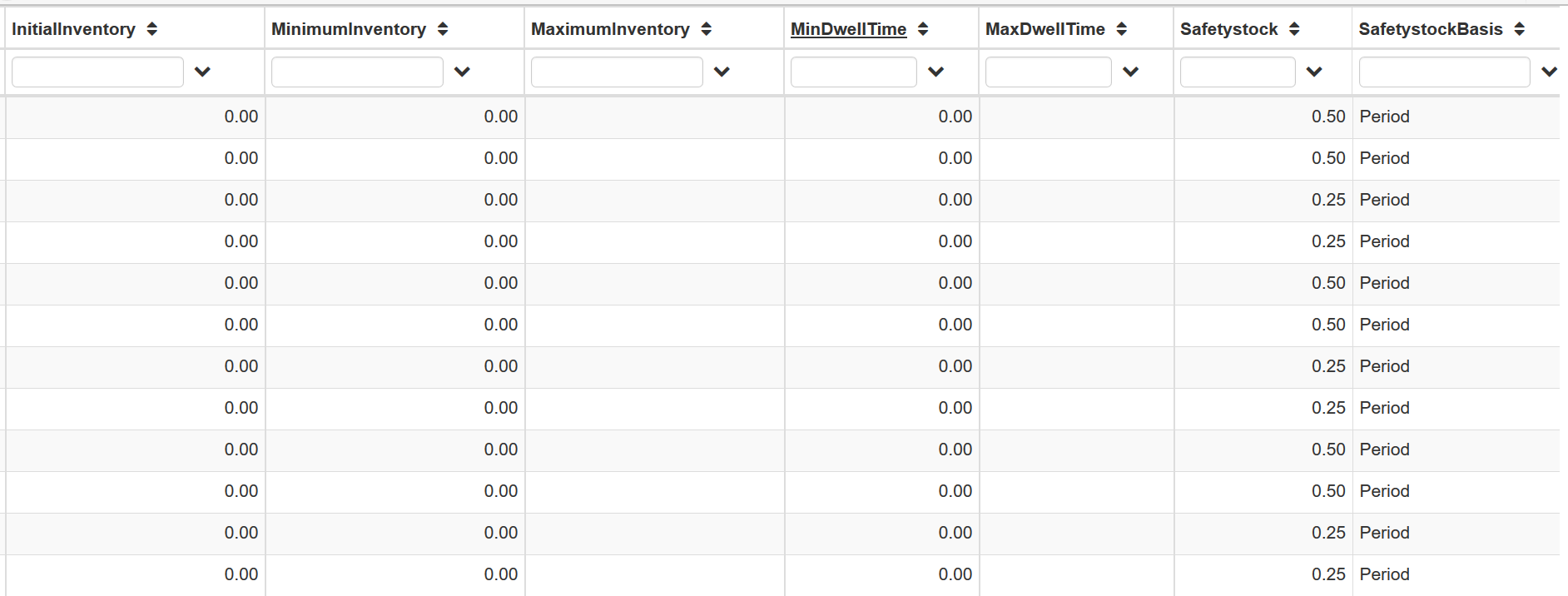Standard Tables¶
Standard tables are input tables which are mandatory of network optimization problem except “Bill of Materials”. These are 7 input tables, which are:
Item
Location
Demand
Inventory Policies
Sourcing Policies
Transportation Policies
Bill of Materials
Item Table¶
Enter SKU data in this table. Underlined columns are mandatory

Item: Enter a unique name/code for the item or SKU.
Item Volume: Enter volume of the SKU in Kilo Letres (KL).
Item Status: User can disable/enable an item in model by changing this parameter to Active/Inactive. Default value is Active.
Case Equivalent: Enter case equivalent conversion of the SKU
Item Weight: Enter weight of the SKU per case.
Brand: Enter Brand categorization
Salience: Enter SKU salience as Mild or Strong
Pack Type: Enter pack type categorization as Quart/Pint/Pint Dozen/Can 330/Can 500/Draught type
MG1: SAP MG1 code
MG2: SAP MG2 code
Size: Enter size as 330/500/550 ML
Item Weight: Enter weight of the SKU per case.
Master Brand Enter master brand categorization of the SKU
Location Table¶
Enter list of all customers, suppliers and existing facility which are in scope for network design model

Location: Enter a unique name/code for each location.
Loc Description: Enter a description for the location, required only for reporting purpose. This field does not derive any functionality.
Loc State/Loc Country: Enter location address details required either for geocoding or reporting purpose.
Loc Type: Classify location in either Facility or Customer Type. A brewery is categorized as a Facility while a market is categorized as a Customer
SAP Code: Enter Brewery/Market SAP code
Brewery Code: Enter brewery code for Facility location types
Loc Status: Enable to Disable a market or brewery by setting this field to Active/Inactive.
Quart/Pint/Pint Dozen/Cans500/Cane330/Draught: Enter “Y”/”N” for these columns if location is a brewery. These fields may be used for reporting or constraint building.
Zone: Enter Zone as North/South/East/West/CSD
Demand Table¶
Enter sales forecast for items and customers for the horizon setup in model parameters.

Item: Enter SKU name/code as defined in Item table.
Location: Enter customer site name/code as defined in Location table.
Arrival Date: Forecast date, if it is a multiperiod model system will use period definition and arrival date to aggregate demand by period else system will assume all the demand in a single period.
Quantity: Demand quantity in K cases.
Demand Status: User may disable/enable demand for a particular customer, SKU or date by setting this field to Inactive/Active.
Inventory Policies Table¶
Enter data related how an item is stored at a facility and what stock norms or costs are associated with it.

Inbound Cost/Inbound Cost Basis: Inbound cost is cost of handing inbound flow per Cost Basis, User may specify inbound cost per unit/weight/volume by setting up Cost Basis field. Inbound Cost default value is set to 0, Inbound Cost Basis default is set to “Quantity”.
Outbound Cost/Outbound Cost Basis: Outbound cost is cost of handing outbound flow per Cost Basis, User may specify outbound cost per unit/weight/volume by setting up Cost Basis field. Outbound Cost default value is set to 0, Outbound Cost Basis default is set to “Quantity”.
Storage Cost/Storage Cost Basis: Storage cost is cost of storing per Storage Basis item per period, User may specify storage cost per unit/weight/volume per period by setting up Cost Basis field. Storage Cost default value is set to 0, Storage Cost Basis default is set to “Quantity”.

Initial Inventory: Enter how many units of this product is on-hand at this site at the start of model horizon. Default value is 0.
Minimum Inventory: Minimum inventory required to maintain for specific item at specified facility for each period. Default value is 0.
Maximum Inventory: Maximum inventory that can be maintained for an item at a specified facility for each period.
Min Dwell Time: Minimum number of periods in which an item must stay at the facility, this field is required only for multiperiod models. For e.g. if this value is set to 2 for a DC and a specific item, items which are received in Period_001 can be dispatched only in Period_003 or later periods.
Max Dwell Time: Maximum number of periods in which an item could stay at the facility, this field is required only for multiperiod models. For e.g. if this value is set to 3 for a DC and a specific item, items received in Period_001 should be dispatched till Period_003.

Safety Stock /Safety Stock Basis: Safety stock required in each period based on safety stock basis, safety stock basis can be Period/Days/Quantity. For e.g. if safety stock is set to 1 and safety stock basis is set to period, system will keep safety stock equal to outbound flow for each period. If safety stock basis is set to quantity then system will keep fixed safety stock in each period.
Inv Turns: Inventory Turns is a ratio showing average no. of replenishments done each period. Inventory Turns is used to calculate average inventory in a period. For e.g. if inventory turn is 4 and throughput is 1000 units, average inventory is ((1000/4)/2) = 125 units.
Inv Carrying Cost (%): Enter Inventory Carrying Cost in %, this value will supersede value from model setup parameters. It is used to calculate Inventory Holding cost based on value and carrying cost %.
Inventory Policy Status: Enable/Disable any inventory policy from the model by setting its status to Active/Inactive.
Sourcing Policies¶
Enter data related to how a product moves in supply chain.

Sourcing Policy: Here, we have 3 types of sourcing policies:
Production: It specifies which SKU is produced in which Brewery.
Inter Facility: It specifies how an item is moved between a source brewery to destination brewery.
Customer Sourcing: It specifies how an item is moved between a source brewery to customer market.
Item: Enter the Item for which sourcing policy applies.
Location: Enter destination location if sourcing policy is of Inter Facility or Customer Sourcing type. For Production sourcing type, enter Production Facility.
Source: Enter Source Facility in case of Inter Facility or Customer Sourcing type and leave blank for Production sourcing type.
COP: Add cost of production per case for Production type sourcing policy
NC: Opportunity cost of shipping one case of selected SKU from selected Brewery to selected market. It is used for shortall optimization, so that total NC could be maximized
Sourcing Policy Status: User may enable/disable a sourcing policy by setting this field to Active/Inactive.
Transportation Policies¶
Enter data related to transportation lanes and cost

Source Location: Enter source location (brewery) from where items will be dispatched, source location will always be of facility type.
Destination Location: Enter destination location (market) for which items will be procured, destination location can be a facility or a customer type.
Mode: Enter transportation mode as Import/Local, Enter mode as Local if source location and destination location are in same state else Import. Mode is used to do local optimization first for intra state supplies and then global optimization for inter state supplies.
Freight: Enter Freight charges to transport 1 case of SKU from Brewery to Market.
Import Fee: Enter import fee per case equivalent for the destination state.
Export Fee: Enter export fee per case equivalent for the source state.
Bottling Fee: Enter bottling fee per case equivalent for the source brewery.
Franchise Fee: Enter Franchise fee per case equivalent for the source brewery.
Cow Cess: Enter cow cess per case equivalent for the destination state.
Corp Margin: Enter corporation margin fee per case equivalent for the source brewery.
Service Charge: Enter service charge fee per case equivalent for the source brewery, only in case of contract brewery.
Duty Cost Basis: Enter CaseEquivalent as Duty cost basis to calculate all the fees except freight in case equivalent.
Transportation Policy Status: User may enable/disable a transportation policy by setting its status to Active/Inactive.